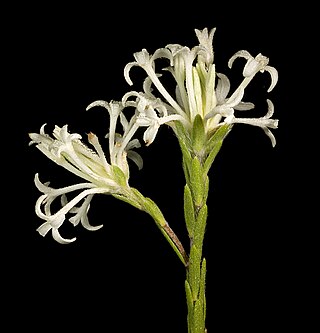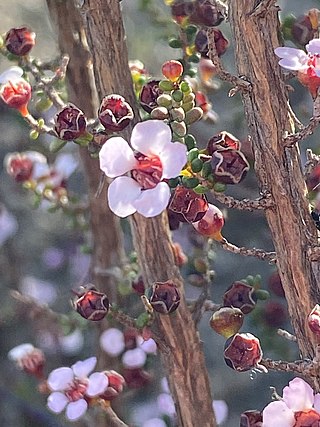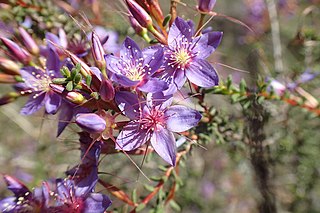
Pimelea longiflora is a species of flowering plant in the family Thymelaeaceae and is endemic to the southwest of Western Australia. It is an erect, spindly shrub with linear to narrowly elliptic leaves and erect clusters of white to cream-coloured flowers, surrounded by 4 to 6 green, egg-shaped involucral bracts.

Rinzia orientalis, commonly known as desert heath-myrtle, is a species of flowering plant in the family Myrtaceae and is endemic to south-eastern Australia. It is a shrub with elliptic to narrowly oblong leaves and white or pale pink flowers usually with ten stamens.
Baeckea latens is a species of flowering plant in the family Myrtaceae and is endemic to the south of Western Australia. It is an upright, spreading shrub with erect, linear leaves and small white flowers with three to ten stamens.
Baeckea pachyphylla is a species of flowering plant in the family Myrtaceae and is endemic to the south of Western Australia. It is a shrub with bilaterally flattened leaves and small white flowers with two to eight stamens.
Baeckea pygmaea is a species of flowering plant in the family Myrtaceae and is endemic to the south-west of Western Australia. It is a slender and erect or spreading shrub with narrowly egg-shaped to almost linear leaves and small white flowers with 12 to 25 stamens.
Baeckea uncinella is a species of flowering plant in the family Myrtaceae and is endemic to the south coast of Western Australia. It is a shrub with narrowly egg-shaped to linear leaves and small white flowers with seven to thirteen stamens.

Calytrix violacea is a species of flowering plant in the myrtle family, Myrtaceae and is endemic to the southwest of Western Australia. It is a shrub with linear to narrowly egg-shaped leaves with the narrower end towards the base, and purple, star-shaped flowers.
Micromyrtus acuta is a species of flowering plant in the myrtle family, Myrtaceae and is endemic to the southwest of Western Australia. It is an erect shrub with small, oblong leaves and small white flowers in the upper leaf axils.
Thryptomene caduca is a species of flowering plant in the family Myrtaceae and is endemic to a small area in the north-west of Western Australia. It is a spreading shrub with crowded egg-shaped leaves with the narrower end towards the base, and pink flowers with five petals and seven to nine stamens.
Thryptomene calcicola is a species of flowering plant in the family Myrtaceae and is endemic to a small area in the north-west of Western Australia. It is an erect, sometimes spreading shrub with upwards-pointing linear leaves, and pinkish-mauve flowers with five petals and ten stamens.
Thryptomene dampieri is a species of flowering plant in the family Myrtaceae and is endemic to the north-west of Western Australia. It is a low, spreading shrub with prostrate stems, broadly egg-shaped leaves with the narrower end towards the base, and pinkish flowers with five petals and ten stamens.
Thryptomene globifera is a species of flowering plant in the family Myrtaceae and is endemic to western areas of Western Australia. It is a shrub with crowded, upward-pointing, broadly egg-shaped leaves with the narrower end towards the base, and pale pink or mauve flowers with ten stamens.
Thryptomene orbiculata is a species of flowering plant in the family Myrtaceae and is endemic to the west of Western Australia. It is a shrub with broadly egg-shaped to more or less round leaves, and flowers with five pinkish petals and usually ten stamens.
Thryptomene pinifolia is a species of flowering plant in the family Myrtaceae and is endemic to Kalbarri National Park in Western Australia. It is a shrub with linear leaves, and flowers with pale pinkish sepals and petals and seven or eight stamens.
Thryptomene podantha is a species of flowering plant in the family Myrtaceae and is endemic to the west of Western Australia. It is a shrub with egg-shaped leaves with the narrower end towards the base, and flowers with pink sepals and petals and ten stamens.
Cryptandra craigiae is a flowering plant in the family Rhamnaceae and is endemic to a restricted area of southern Western Australia. It is a shrub with linear leaves and dense clusters of white or cream-coloured, tube-shaped flowers.
Cryptandra graniticola is a flowering plant in the family Rhamnaceae and is endemic to southern Western Australia. It is an upright, spreading shrub with spiny branchlets, linear to narrowly egg-shaped leaves and clusters of white, tube-shaped flowers.
Cryptandra intermedia is a flowering plant in the family Rhamnaceae and is endemic to the southwest of Western Australia. It is a small shrub, usually with spiny branchlets, elliptic to linear leaves and spike-like clusters of white, tube-shaped flowers.
Cryptandra micrantha is a flowering plant in the family Rhamnaceae and is endemic to the southwest of Western Australia. It is a prostrate or upright shrub with spiny branchlets, narrowly oblong to elliptic leaves and dense clusters of white or cream-coloured, tube-shaped flowers.

Cryptandra recurva is a flowering plant in the family Rhamnaceae and is endemic to Western Australia. It is an erect, spreading shrub with densely hairy young stems, narrowly oblong to narrowly egg-shaped leaves and clusters of white, cream-coloured or off-white, tube-shaped flowers.



